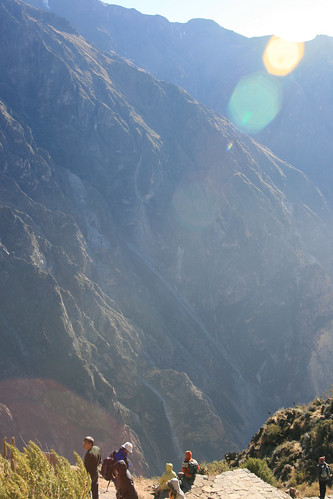Today we embark on a virtual trip to the charming colonial city of Arequipa, the second largest city of Peru, this is located at 2,350 meters above sea level due to the canyon region and the immense Apus (mountains in Quechua it meant to the Inca civilization protection and respect).

Photography by nerdcoregirl
In our journey prune enter the Natural Reserve of Salinas and Aguada Blanca, in the Colca Canyon (is 3.191m, is the second deepest canyon in the world after Cotahuasi, belonging also to the geography of Peru), where the far we can see the mysterious Ampato to 6,310 meters above sea level, famous for its crater was discovered in four of the eighteen mummies of children placed in sacrifice to the mountains in the Inca empire.
The most famous of these bodies and the best preserved is the mummy Juanita (the famous «Ice Princess» Inca sacrifice to the gods) is rescued by the mountaineer and archaeologist Johan Reinhard.

Photography by An en Alain
An unpaved side road takes us to the highest point of our trip: the viewpoint of the Andes, which is 4,900 meters above sea level. From there, we’re slowly becoming out of breath not only by lack of oxygen due to altitude and altitude sickness or altitude sickness, but once we got to the canyon and we are amazed at the spectacular view of the majestic condor, which with its wings spread can reach 3 meters in length planning on Colca River Valley. No radio signal or cellular in more than 500 km radius. It is the reunion of man with his own essence, the origin of all life: the immense and almost mystical ritual of sacred silence.
Balcony of Los Andes:
Lakes and ponds are frozen up here, due to the significant drop in temperature (at night it reaches 15 degrees below zero) as you ascend to the heights of the Andes. The peaks are bathed in immaculate white snow for 365 days a year. The air is cold and sharp, and completely blue sky. However, the sun shines during the day, reaching the Colca region semi-tropical microclimate during the few hours of daylight. This place is inhabited only by sheep and vicuna, Andean is a species that resembles a gazelle with very long necks and feeds on shrubs and herbs typical of the region.

Photography by Jake G
At night you can see the stars in the southern hemisphere from the planetary hotel. Under the winter sky you can see clearly the Southern Cross, which indicates the direction to the southernmost point of our planet, the polar south.
Discover the sacred land of the Incas in Peru!
Leave a Reply
You must be logged in to post a comment.
Recent Comments